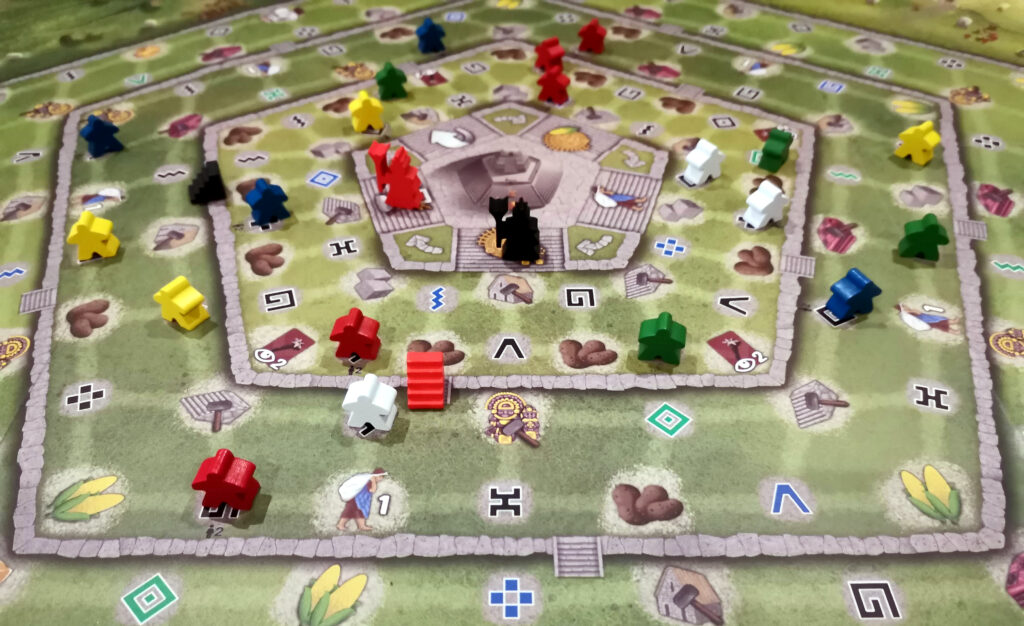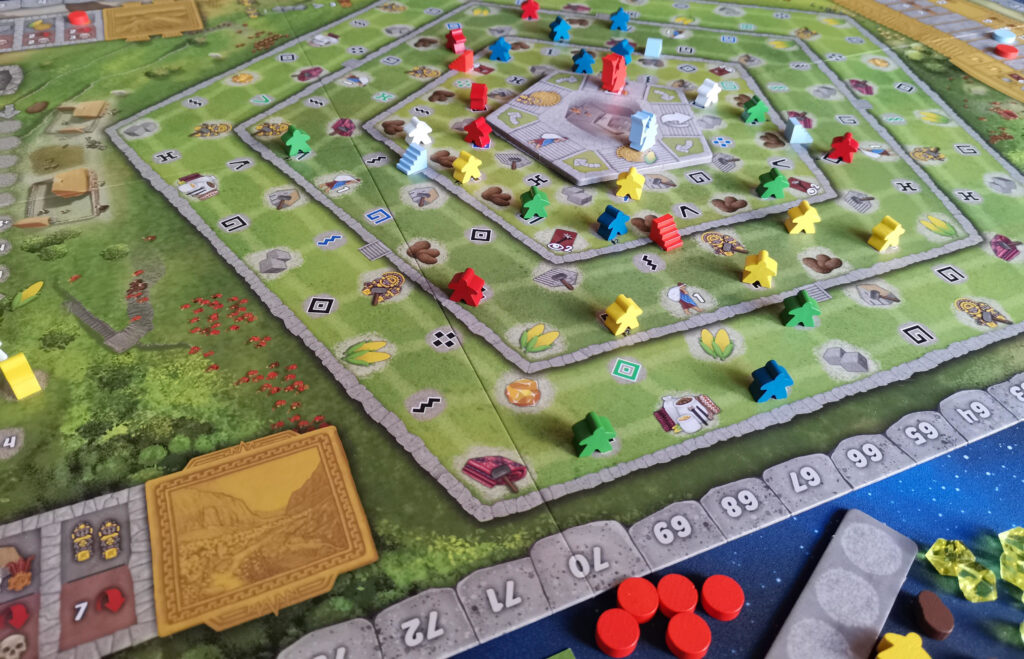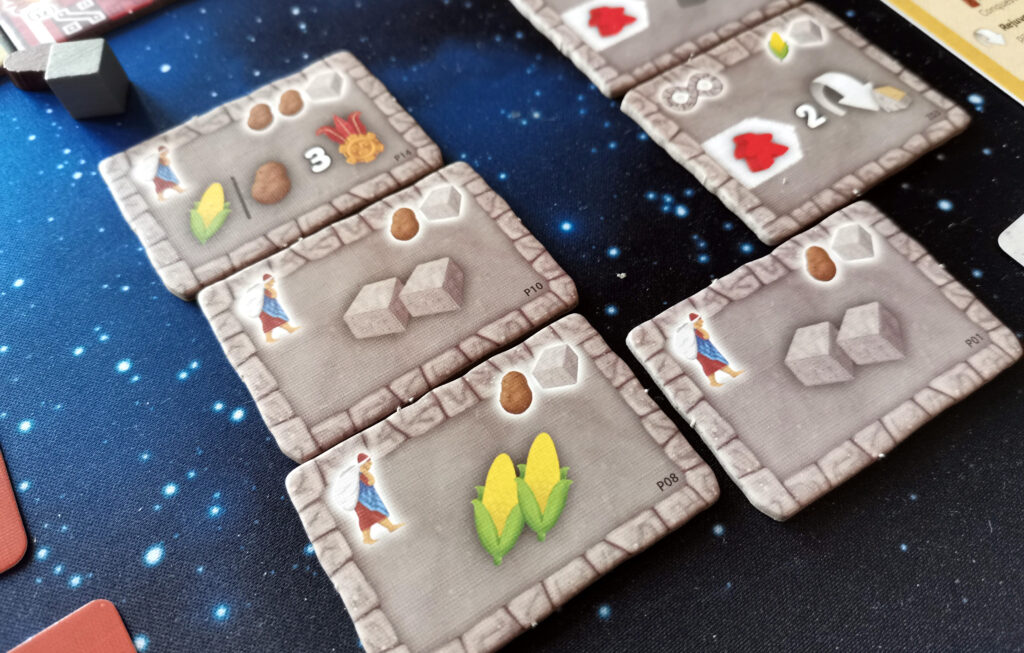If you’re reading the name of the game over, and over, trying to figure out how to say it, you’re not alone. Tawantinsuyu is the latest in a series of games from Board & Dice with fun-to-say names that begin with the letter T. Let’s see what this heavyweight Euro game has in store for us.
Dávid Turczi is the brains behind Tawantinsuyu, the same mind that brought us Anachrony. It’s a game about raising a team of workers in the shadow of the Sun Temple, at the site of the ancient terraced Incan capital, Cusco. Along the way you’ll be constructing buildings and statues, weaving tapestries, harvesting corn and potatoes, and even going to war. But, as you might expect from a heavy Euro, the theme is only skin-deep, so lets get into the bit we’re all here for – the game!
Mixing Mechanisms
Much of Tawantinsuyu revolves around two main mechanisms: worker placement, and a rondel. In the centre of the board, atop the terraced pentagonal hill, players’ High Priests occupy one of five places. One of the two options available to you on your turn is to move your priest one or two steps around, rondel-style. The spaces they occupy let you perform one of the major actions available, such as conquering nearby villages or making your buildings produce resources for you.

Alternatively, you might choose to place one of your recruited workers in one of the spots available on the board. This seems pretty standard fare for anyone who’s played a worker placement game before. Find an empty space, pay any costs associated, get the thing from the space. But Tawantinsuyu spices things up here, and gives you so many things to consider that your brain could melt, in the nicest possible way.
Let’s Get To Work
I’ll try to illustrate just how many things you have to think about every time you place a worker. Workers come in five colours. Some you’ll take at random at the start of the game, the rest you’ll choose. Firstly, every worker space is connected to three possible actions, so there’s the choice of which one of the three you perform. Unless, that is, your worker is adjacent to another worker of the same colour. Then you get an extra action for each adjacent, same-colour worker. So now you might have three actions, so you can perform all three things, hooray.
On the subject of worker colour, each different colour has an associated bonus. White ones, for example, let you take an additional action if you pay one potato. Green and blue workers, when placed on spaces of their own colour, give you an additional action. All of those bonus actions are in addition to the adjacency bonuses mentioned above, so a clever placement can net you five actions from placing one worker.

But wait, there’s more! Each worker space has a symbol on it, and to place someone on this symbol, you need to discard a God Card with that symbol on it, or some gold. Oh, and you need to pay food if the space is on a lower terrace of the hill, and again if the space is on a different side of the hill to your High Priest.
So you see, the simple action of placing a meeple on a space on the board needs a lot of thought behind it, if you want to be efficient.
Controlling The Pace
If you read my review of Viscounts of the West Kingdom, you’ll remember that one of things I really liked about it was not having a set number of turns. Plenty of Euro games dictate that you’ll take a certain number of actions, then it’s game over. Tawantinsuyu is another of those that doesn’t do this, and it’s something I find myself enjoying more and more.
There is a set number of rounds in the game, but the triggering of the end of the round is done by the players. When the last worker from the village area is claimed by a player, it triggers a festival, and end of round scoring. But you don’t have to take that worker. Workers cost food to take, and there’s a second space to collect Nomad workers from. Or you could place a red warrior worker, which lets you take an adjacent worker from the board and claim them to use on a later turn. You don’t even have to place a worker, you could take a High Priest action instead.

This all leads to a really tense game of cat and mouse when the village is down to its last worker. You might avoid taking it, to try and get another action somewhere else, or you might take it just to stop an opponent doing the same thing. It’s another layer in this stack of complexity pancakes, and it just makes the whole thing more delicious, and even more to chew on.
Choosing A Path
Like Teotihuacan before it, there are a lot of ways to score points in Tawantinsuyu. What I appreciate in the design of this game is the ability to change your chosen route to victory partway through the game. Some games can feel quite punishing if you change strategy, leaving you unable to catch someone who chose well at the start of the game. If you’ve ever played 7 Wonders: Duel before, and decided to try to chase a military victory halfway through the game, you’ll know what I mean.
Tawantinsuyu doesn’t do this. I’ve played games where I’ve abandoned my quest to become the tapestry magnate of Cusco, choosing to become a bloodthirsty warmonger instead, and still won the game. The trick to this game is about using actions efficiently. After a couple of games, placing a worker and only getting one action from it feels deflating, like you’ve made a mistake. You haven’t done anything wrong really, but you’ve probably missed something that could have gained you more, and your own brain will beat you up for it.

If you want to play well, you need to have your wits about you, have an open mind, and be aware of what’s going on at all times. Which spaces are available? How many potatoes has your opponent got? Can their High Priest get to the rejuvenate action and revive his army before you start a conquest and mop up all the points? These thoughts and considerations, these are what make a game heavy, not the complexity or thickness of its rule book.
Does Heavy Equal Fun?
For some people, probably not. My wife for example, doesn’t like any game that feels like hard work, mentally. For people like me though, this game is Fun with a capital F. That abundance of choices is wonderful, and the clever ways interactions work in the game aren’t blatant, but are satisfying all the same.
Take stairs, for example. Any player can construct stairs as an action, and then they can place a cute little set of stairs on the board between the terraces. Stairs decrease the food cost for placing a worker on a lower tier. But if you use someone else’s stairs to do this, they get 1 VP for it. If you build steps on a lower tier, and your opponent built the steps on the tier above, they get 2 VPs for it. These don’t sound like big numbers, but games of Tawantinsuyu can swing on these small gains.
Considerations like these are what makes a game heavy for me. The actions you perform aren’t difficult, and there are no overly confusing rules or conditions, but choosing from the wealth of viable options is tricky.
Solo Mode
I’m a huge fan of Dávid’s solo modes in games, and Tawantinsuyu is no exception. Anybody who’s played against the Chronobot in Anachrony will spot the similarities. The Axomamma automa player has its own special player board, rules and die to roll. It’s really simple to run, following a set of priorities, and moving some tokens around on its board.

Axomamma plays a good game, and like all the best solo opponents, it does two things really well. Firstly, it has varying difficulty levels, which means you can start on the easiest settings and work up. This is great, as there’s something very dispiriting about getting hammered by a piece of cardboard or a few cards. Secondly, and the most important thing for me, is that it feels like playing against a human opponent. Axomamma earns resources and spends them, just like you do, and it really makes a difference to the experience of playing solo.
Final Thoughts
Tawantinsuyu is a masterclass in heavy, mechanical, Euro game design. The board isn’t going to win any illustration awards, but as an exercise in graphic design, it’s great. The iconography is clean and consistent, and once you get the hang of the game, the only time you’ll need to refer to rule book is to look up a passive building you haven’t used before. Thematically, I never really get the feeling I’m developing an Incan tribe, but that’s not what most people buying this game will be looking for.

This game is ridiculously satisfying, every single turn is like being a kid in a sweet shop – you don’t know where to start, because you want to try everything. I love the feeling of placing a worker in the perfect spot and getting a ton of stuff from the four or five actions it gives you. There are some parts of the game which – understandably – feel influenced by Teotihuacan, most notably when each round ends with a special round of scoring. In Teotihuacan you have to pay cocoa for workers in your possession, and in Tawantinsuyu you need to pay potatoes for every God card you’ve got. The big difference though is potatoes never feel as hard to come by as cocoa did. It’s maybe a small detail, but it means I can enjoy the game more.
While I was writing drafts for this review, I was trying to make sure I covered any negatives in the game, and honestly, I really struggled. I think the only thing I’d say is that it takes up a lot of table, so if space is an issue for you, be careful.
If you like a heavy game, and you like worker placement, buy Tawantinsuyu. That’s how much I like this game. I haven’t been paid to say that, I wasn’t even provided with a review copy of the game. I bought it with my own money – which is affordable at the time of writing, at around £40 – and I’d buy it again in a heartbeat.

Totally agree. This game is fantastic, and I love David Turczi. I own almost all of his games so far (with a handful still to play). I won my very first game of Tawantinsuyu, 165 to 157. Going through my second game now. The A.I. is up by only 5 points, and I’m approaching the third and final festival. I love a good, tense game like this where the scores always seem to be close the whole way through. I also find the game to be a mix of strategy and tactics. My main strategy is always to set up my high priest actions with my workers, treating the priest like a rondel. I have to say that Tawantinsuyu truly is a magnum opus for Mr. Turczi. I’ll be getting to Tekhenu, Trickerion, and Dice Settlers next.